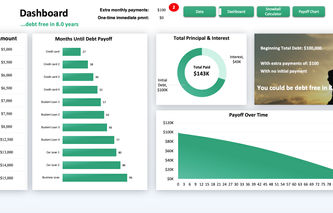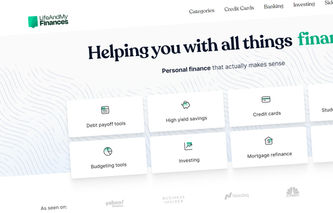You’ve seen it on TV—a brilliant investor takes out a loan, buys dozens of properties, flips them for profit, and pays off their loan.
They get book deals and TV shows and make it look easy.
(Unlike your friends who took out a loan, bought a property, failed to flip it, and almost got divorce. Twice.)
Forget bravado as a tactic and rely on a proven strategy—the BRRRR method.
Let’s BRRRRing it—
What is the BRRRR Method?
The BRRRR method is a real estate investment strategy for buying, renovating, and renting out properties. The technique involves finding cheap properties, flipping them to use as rentals, cashing out on their equity, and then beginning the process again to fund another investment.
What does BRRRR mean?
BRRRR is an acronym for Buy, Rehab, Rent, Refinance, Repeat (also known as Buy, Renovate, Rent, Refinance, Repeat).
It's a solid business model if you want to be a landlord or if your goal is to quickly turn a hefty profit on your properties.
What is a BRRRR property?
BRRRR real estate covers many properties, including homes, duplexes, triplexes, and commercial units. Any real estate you can buy, fix up, rent out, and refinance can be a BRRRR property.
For the BRRRR formula to work, you already need to know the basics of renovation strategy. If you've never tried flipping a house for a profit, make sure you understand what it takes to renovate.
How Does the BRRRR Method Work?
The BRRRR investing strategy is essentially buying a property low—doing some minor renovations—renting it out—then using the equity to refinance and purchase another property—then repeating over and over until you have a property empire.
If you follow those four steps every time you go from one investment opportunity to another, you should be able to do the BRRRR method successfully. You’ll need to keep track of a few things to make a success of the BRRRR strategy:
The length of each stage (how long did it take to find, buy, renovate, and rent out your properties).
How much did you spend during each step (down payments, repair costs, monthly bills)?
How much equity you’ve created with every deal?
The major difference between the BRRRR method and others is the focus on distressed properties or properties in areas that need revitalization.
If you can spot the potential in a renovation and aren’t afraid of doing the hard work, there’s a ton of money to be made.
But if you’ve never tried to flip a property, that still leaves the question of how to start the BRRRR method. It all begins with B—buy!
BRRRR Strategy Step by Step
Let’s break down the BRRRR method for beginners (and include some examples along the way).
Buy
Buy low, sell high. That’s the house-flipping mantra. When buying BRRRR real estate, you’ll want to aim really low. A word of warning—most of the risks can be found at this first stage, so you must get it right.
What’s on the checklist to find a BRRRR property worthy of your hard work? Since the whole point of the BRRRR method is to add value, start with a place that needs repair—a real fixer-upper (or a distressed property as they’re known in the trade).
Finding the balance between the buying price, the cost of the work involved, and the end value of the real estate is critical. Before you jump into the world of BRRRR, let’s learn some of the lingo.
The first thing to know—ARV
That's the After Repair Value, an estimate of the property's worth after you've done the repairs and renovations. Adding the refurb value is tricky and subjective, but you can get a rough idea from the prices of similar homes in the area with the same level of finish.
A rule of thumb is to spend only 70% of the ARV minus cost of repairs.
The formula is:(ARV x 70%) – Repair Costs = Maximum Bid This is called—quite unsurprisingly—the “70% Rule” in real estate circles. Here’s an example of what it means in practice:
Asking price | $250,000 |
|---|---|
Value added by renovations | $50,000 |
ESTIMATED ARV | $300,000 |
70% Rule | $210,000 |
Repair costs | $10,000 |
Maximum bid | $200,000 |
When buying property to make money, it’s essential to leave a margin for error. Following the 70% Rule gives you reassurance that you’ll complete the project and come out with some equity.
Before you buy, do your research
You should know:
How likely it is that you will get a mortgage on the property (B).
How much roughly the renovation will cost (R).
The availability and price of other rentals in the area (R).
What refinancing options you’ll have on the property after refurb (R).
How much cash you’ll have for the next project (R).
On average, most investors will spend around $10,000–$20,000 to start investing in real estate using the BRRRR strategy, but this number could vary depending on where you live.
If you think you've found the perfect investment but you're having trouble running the numbers, take a look at a BRRRR calculator. You can find these online, and by plugging a few numbers in, you'll see what kind of profit (or loss) you might make.
Remember, a calculator can't tell you exactly how things will go or predict any unforeseen circumstances, so use the numbers as a rough guide.
Rehab
When you renovate, don't go overboard. That's the top tip. Create a budget, leave room for unforeseen expenses, and keep the bigger goal in mind. Don't start by shopping for marble countertops and shag pile carpeting. At this stage, you want to make sure your property is habitable.
Start by giving your property a full review. Check out:
Foundation/structure
Electrical wiring
Plumbing
Heating
Insulation
Windows
Look for anything that might not be up to code. Every state (even every locality) has its own building codes you’ll need to meet. You’ll find them online. You can check out the FEMA building codes for a federal overview. If your rehab doesn’t meet those standards, it means you’re doing something wrong.
If there’s construction work to be done, get quotes from a few contractors and crunch the numbers. Figure out where you can cut back on cosmetics to make the place habitable. And remember, you’ll be renting it out, so you’re going to be responsible for repairs and maintenance. Don’t scrimp on areas that’ll come back to bite you.
The roof, for example, might be okay when you buy it, but after a few years of wear and tear will become a lot more costly than touching it up now. Once you have any structural or major work out of the way, it’s time for the fun—bring on those marble countertops!
Or—more reasonably—go utilitarian. Maybe marble-effect countertops would look just as nice? Overspending will lower your return on investment. Do some cost-benefit analysis to see how to get back the maximum outlay at this initial stage.
From the beginning, think about how much rent you’re going to charge and plan your final cosmetic work accordingly. Curb appeal matters, sure, but you’re not actually going to live there.
Rent
The next stage in the BRRRR investment plan is to figure out your rent. Time for another well-named rule!
How to estimate the rent price
The “1% Rule” is popular with BRRRR method veterans, a simple piece of math to estimate how much you should charge per month. This should be at least the amount you pay for the mortgage (if you have one).Otherwise, you certainly won’t break even.
Time for more BRRRR method examples: Say you’ve spent $250,000 buying and renovating your BRRRR property. $250,000 x 1% = $2,500. You'll need to charge at least $2,500 a month to cover your expenses.
It's a rough estimate because it doesn't consider other operating costs (like a rental manager) or how much other rental units in the area make in comparison.
Before buying, be sure to know the typical rental rates in the area. If they’re far less than 1% of your purchase price, then buying and renting a property in that neighbourhood makes little sense.
Finding Renters
After that, it’s time to find a suitable rental candidate. Don’t just go sticking flyers up on telephone poles, though. You need to be more discerning than that. You’re a landlord now, after all.
Set some requirements, like income, age, employment history, and credit score. You can ban pets and smokers, too. Having rental criteria will help you find the best tenant. You'll hopefully be working with this person for a while to come, so get it right.
After you've got a few applications, narrow down your search. Look into the rental history of your candidates and run a credit check because a strong history with solid references can save a lot of headaches later.
Remember, a stable rental history on your property will be important when it's time to refinance, so take the time to get the right tenant.
Since you'll soon be busy finding and flipping other BRRRR properties, it's even worth hiring a rental manager as your tenant's point of contact. Just be sure to factor this into your ongoing costs.
Refinance
Before you start over again, there's one last step to the BRRRR method—the BRRRR refinance. This can be tricky, so let's get this right.
First, you built up equity in your property and then found a stable tenant. That's going to look great to whatever lender you approach for refinancing your property.
They'll also want to see your credit report, the cash flow on the property, and an appraisal. Every lender will have their criteria, but so will you for taking their money.
First, only take a BRRRR cash-out refinance. That’s when your current mortgage is replaced with a new one that taps into the equity you’ve built up in the property. You’ll have a higher loan amount on the new mortgage and get the difference in cash.
Check out your mortgage refinancing options before you commit. You can review some of the best rates through Credible’s comparison tool.
Another potential pitfall is the requirement for an appraisal. This is one of the less well-known BRRRR method risks. And in some ways, you have no control over it. The rehab might have gone great, and your property could be the best on the block, but the value might still have fallen in a market slump.
If that’s the case, consider holding onto the property a little longer before trying to refinance. Become a fantastic, attentive landlord, sketch out plans for the next five years, and go for it when the market picks up again!
Repeat
The last part of our BRRRR strategy step-by-step guide is simple. Do it all over again. After the first go-round, you'll be able to answer a simple question: "Is the BRRRR method worth it?" It can be a steep learning curve, but take everything you've learned and apply it to your next diamond in the rough. You've just got to find it first.
What Do The Experts Have to Say About the BRRRR Method?
Curious about the BRRRR method? Wondering what the experts have to say? Mark Ferguson—founder of InvestFourMore.com and an avid investor in real estate—has this to say about the BRRRR method:
"I personally love the BRRRR strategy but still flip as well. I tend to flip the properties l that are still good deals but don't have the cash flow. Many houses in my area fit this box since prices have gone up higher than rents. BRRRR works great on multifamily or commercial with better cash flow. Higher interest rates have made it tougher, but I always leave room for unknowns like surprise repairs or financing changes."
How to Find BRRRR Properties
When looking for new BRRRR real estate projects, you can't only browse the same realty websites as everyone else. Instead, get creative to find a deal on your next property.
1. Take part in property auctions
Auctions are always going to be a goldmine for BRRRR investors. Unfortunately, that means the competition can be fierce too.
Before you make that winning bid, read through the legal pack for properties you’re interested in. This will give you the conditions of sale, a look at land registry documents, and info on any tenancy agreements. You can find local auctions through sites like RealtyTrac and Auction.com.
2. Search online property listings
Have you tried Googling “cheap properties for sale near me”? I’m only half-joking there. There are a ton of property websites out there that might hold your next dream project.
Easily set up alerts for properties going up for sale that meet your requirements. A quick search will generate leads specific to your area and any realtors who specialize in the buildings you're looking for.
3. Find repossessions and foreclosures
It’s pretty simple to find repossessed and foreclosed properties for sale. The mortgage giant Freddie Mac sells foreclosed homes on its site HomeSteps, and you can even find foreclosures through the Department of Housing and Urban Development.
Major realtors tend to list repossessions on their websites (as do some of the biggest banks in the country, like the Bank of America). Find them quick, though, because according to the latest data, the number of foreclosed homes is going down year-on-year.
4. Buy from a real estate wholesaler
Wholesalers find cheap, usually distressed, properties from owners that haven't tried to put their house on the market and snap them up for a reasonable price.
A short time later, without doing much of anything to the property, the wholesaler reaches out to find an investor who wants to flip, puts a little extra on the top, and sells for a tidy profit. As a BRRRR investment strategy, it leaves a lot to be desired.
Ideally, you'd find these properties and avoid paying the inflated fees a wholesaler adds. You'll need to keep your eyes peeled for local adverts (either on or offline) and try networking.
5. Drive for dollars
Or skip the middleman altogether, and find these homes yourself. As a BRRRR strategy, this is the most chaotic choice you can make, but it still works. It involves driving around an area you're interested in, finding homes you think might be worth an investment, and making an offer to the homeowner.
Turning up at someone's door and offering to buy their house takes guts, but it can reap the rewards. Homeowners often won't put a dilapidated property on the market because they don't see the point. It isn't worth the hassle or the legal fees. You can make it easy by offering to buy them out.
BRRRR Method for Beginners
We’ve told you what BRRRR means, how to do the BRRRR method step by step, and how to find BRRRR properties. Now you’ll find out where to start.
How to find BRRRR Loans
Finding BRRRR financing isn’t as easy as just buying a regular home. Some specific loan types, like the FHA 203k, are made for people buying fixer-uppers and renovating them.
Unfortunately, you cannot use a 203k loan on an investment property. It has to be owner-occupied, not made for renting. For BRRRR loans, you can look to traditional banks, mortgage providers, and dedicated BRRRR lenders.
Investors will need a strong credit score (usually above 700) to qualify for financing through traditional methods like banks or mortgage brokers.
Luckily, many lenders now offer loans geared toward BRRRR investors looking for fast returns. These loans require smaller down payments than traditional bank mortgages, meaning the entry barrier is lower.
They also allow borrowers to make monthly interest-only payments. Though lending institutions often prefer buyers with high credit scores, lenders out there will give mortgages to people with lower scores to finance a fixer-upper. You’ll need to speak directly with lenders to understand your options for financing your BRRRR investment.
Be aware that BRRRR lenders might offer loans that have higher rates, but equally that traditional lenders will most likely base any loans on the purchase price. You might make use of a home equity line of credit (HELOC) to finance your BRRRR purchase, but that puts the equity of your current property at high risk.
BRRRR Method vs Flipping
Real estate investors talk a lot about flipping their way to millions. Not as many consider the BRRRR strategy, so let’s take a sec to compare these two approaches.
The initial aim of both is to find distressed properties with potential and buy them up cheaply. And both methods entail some renovation work to add value to a fixer-upper. Now comes the split in direction.
House flippers are looking to sell a renovation project ASAP, take the profit, and plod it straight back into their next venture. BRRRR method followers don’t sell up. They find a renter, build more equity in the property, and use that to fund their next project.
When you compare the BRRRR method vs. flipping, it takes a lot longer to complete a strategy cycle, and it can cost more in the short term. That’s okay because your eyes are on that sweet rental prize that keeps the cash flow coming long after house flippers burn through theirs.
How Long Does the BRRRR Method Take?
Figuring out how to use the BRRRR method means deciding how fast you want to go. Of all the stages (buy, renovate, rent, refinance, repeat), the first two will take the longest.
Finding the right property won’t be a cakewalk if you do it properly. And the rehab stage could take weeks or months to complete. The quicker, the better, since you don’t start making any money back on your investment before hitting the rental stage.
There are no hard and fast numbers to tell you how long to complete one round of the BRRRR strategy takes, just like it’s difficult to give an exact BRRRR method success rate. But remember that a six-month seasoning period isn’t uncommon for lenders to impose before letting you refinance.
There are some insane stories of investors buying up and rehabbing over fifty properties in the space of six months, but let's say that’s a risky strategy. If you’re starting out, take it slow and try to get everything right the first time. That’s the best way to set up the next BRRRR cycle for success.
Buy Rehab Rent Refinance Repeat: The Cycle Ends
And that’s the BRRRR method explained. If you want to get into the real estate market with little money, the BRRRR method is a viable strategy.
Remember, you may not see much of your profits from one deal to the next, but they’ll add up over time. Whether you choose to go with it full throttle or just incorporate pieces here and there, the key is figuring out what's going to work best for you in terms of financial investment versus risk tolerance.
Is the BRRRR method good enough for you to try? Oh, wait, you’re already looking for your keys to go driving for dollars?

.jpg)



